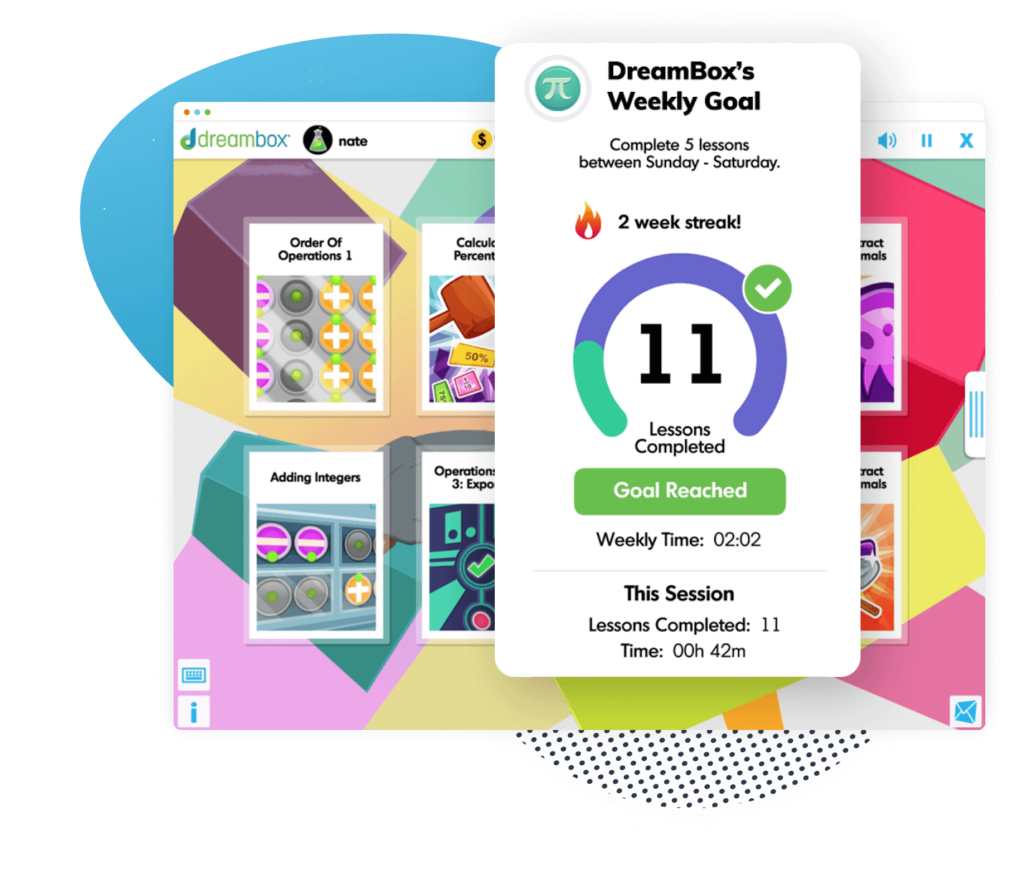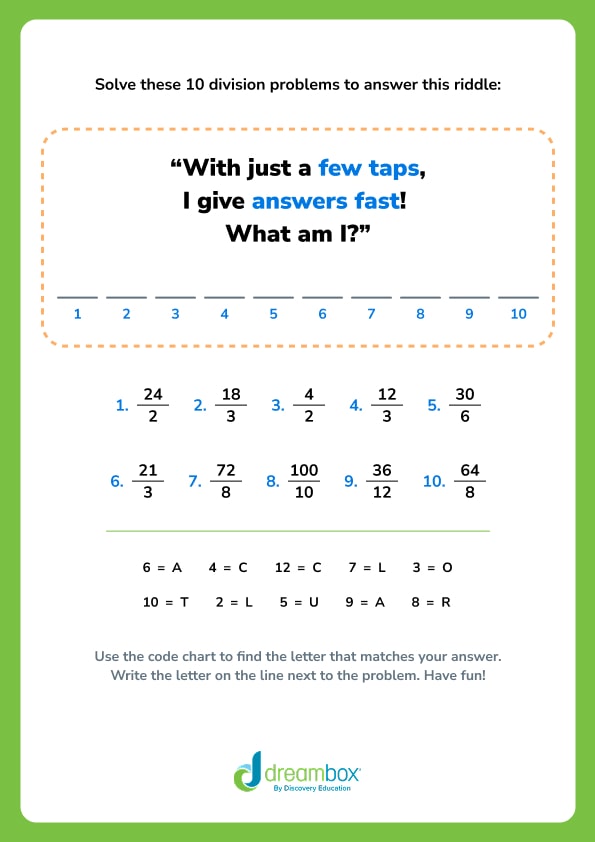3rd Grade Division Problems
In 3rd grade, students are ready to tackle division! Help make learning this new skill fun and engaging with our 3rd grade division problems.

Author
Katie Wickliff
Published:
Aug 2025
Key takeaways
- • By 3rd grade, most students are developmentally ready to learn division
- • Highlighting the relationship between multiplication and division is an important part of learning this new skill
- • Connecting math with everyday life makes learning division more meaningful
In 3rd grade, friendships become very important. It’s not unusual to look around a classroom and see kids trading friendship bracelets, stickers, or mini erasers. They’re also starting to help out more at home, whether by baking treats in the kitchen or helping out in the garden.
Third grade is an ideal time to learn division, as it helps children understand how to share things fairly, both with friends and in everyday life. Learning to divide also helps 3rd graders become more confident mathematicians, preparing them to tackle more complex math in later grades.
In this guide, we’ll explain why 3rd graders are developmentally ready to handle division, how it connects to multiplication, and why it’s important in the real world. We also include 20 practice problems to give you an idea of the types of division 3rd graders see in the classroom or homeschool. Finally, we share tips on how to make division fun and strategies for helping students who are struggling with this concept.
Understanding Division in 3rd Grade
At 8 or 9 years old, students are developmentally ready to start learning division. They can think more logically, recognize patterns, and understand the concept of equal groups, making it easier for them to connect division with the real world, like sharing school supplies or planting flowers in equal rows. By 3rd grade, most students have a solid foundation of addition and subtraction, and are building fluency with multiplication through fact practice and word problems.
Multiplication and division are closely intertwined. Multiplication puts equal groups together to find a total, while division splits the total into equal groups. So, if your child knows that 8 x 3 = 24, they can use that fact to figure out 24 ÷ 8= 3, or 24 ÷ 3 = 8. Understanding how multiplication and division work together strengthens overall number sense and makes learning this new operation feel manageable.
Table of contents
Get more 3rd grade math practice with DreamBox
10 Real-World Division Word Problems
When students wonder when they’ll use math concepts outside the classroom, you can assure them–division is everywhere! In fact, most of us use division every day without even thinking about it. These 10 real world word problems allow students to practice division with relatable, everyday scenarios.
1. The Lakeview Lions have 15 basketball players. If each practice squad has 5 players, how many squads does the team have?
2. Elorie bakes 24 cupcakes for her birthday party and wants to put them in boxes that fit 6 cupcakes each. How many boxes will she fill?
3. There are 72 books in the 3rd grade library. If the class puts an even number of books on 9 shelves, how many books are on each shelf?
4. Tavi makes 13 keychains for his friends. He wants to give an equal number of keychains to each of his 4 friends. Can he do this evenly?
5. Mr. Griffin gives a group of students 18 markers. Each student gets 3 markers. How many students are in the group?
6. Krissa makes 42 beaded necklaces. She wants to share them equally between herself and 6 friends. How many necklaces do they each get?
7. A football coach has 56 flags for his flag football team. If he divides the flags equally among 8 players, how many flags does each player get?
8. There are 36 puppies at the adoption fair. If each playpen can hold 9 puppies, how many playpens does the fair need?
9. A class of 27 students is going on a field trip. The cafeteria makes sandwiches that are placed into buckets, and each bucket holds 3 sandwiches. How many buckets do they need? If the cafeteria packs two more buckets full of lunches, how many sandwiches will there be all together?
10. There are 50 soccer players signed up for the clinic. Each team needs 8 players. How many full teams can they make? How many players will be left without a team?
10 3rd Grade Division Practice Problems

The math program that drives results
Get started today!
DreamBox adapts to your child’s level and learning needs, ensuring they are appropriately challenged and get confidence-building wins.
4 Ways of Applying Division to Everyday Life
From the kitchen, the garden, to family road trips and party planning, division is everywhere! If your child is wondering where they’ll use division outside the classroom, here are several examples you can share:
- Travel: Turn a family road trip into a division challenge. Tell your child the total distance and how many times you’ll stop along the way. For example: “Our trip is 150 miles, and we’ll stop twice for gas and food. How can we split the trip into equal driving segments?” They’ll figure out that 150 miles ÷ 3 segments (two stops plus the final stretch) means driving 50 miles before each break.
- Pizza Party: Use your next pizza party as a chance to practice dividing items up fairly. For example, “We bought two large pizzas with 10 slices each. There will be 5 kids at the party, so how many slices can each of you get equally?” This requires them to add (10 + 10 = 20 for the two pizzas), then divide the total by 5 to understand that each person will get 4 slices of pizza.
- Chores: When it comes to chores, kids have a “fairness” radar– they definitely want to make sure their siblings are doing just as much work! Help kids learn to divide tasks equally, such as “We have 18 towels to fold and 3 people helping. How many towels should each of us fold?”
- Gardening: When working outside the house, dividing tasks like planting seeds or watering plants is a great way to show kids how division can help get work done efficiently. For example, “Between hanging flower pots, windowsill planters, and a bed of vegetables, we have 14 areas to water. How can we split it fairly between both of us?”
Answers
Real-World Division Word Problem Answers
- 3 squads
- 4 boxes
- 8 books
- No, 4 does not go into 13 evenly. Each friend gets 3 keychains, and 1 is left over.
- 6 students
- 7 necklaces (Krissa is included in the group)
- 7 flags
- 4 playpens
- Answer 1: 9 buckets
Answer 2: 33 sandwiches - Answer 1: 6 full teams
Answer 2: 2 players will be left without a team
Division Problem Answers
- C
- A
- L
- C
- U
- L
- A
- T
- O
- R
FAQs about 3rd grade Division Problems
Learning division doesn’t have to be a slog– it’s actually easy to teach students this operation in fun and engaging ways. Using books, puzzles, or online math games bring division to life, while practicing with items that kids value, snacks, toys, or money, will increase their motivation and excitement for learning. Above all, connecting math with the real world makes learning division more meaningful.
If your child is struggling with division, check their multiplication skills. Since multiplication and division are intertwined, students who feel confident about their multiplication abilities are more likely to understand this connection. If your student is still a little shaky with their multiplication facts, concentrate on getting those solid. Use everyday situations to show how division and multiplication works in real life.
If the process seems overwhelming for your child, break problems into small steps and have them draw pictures or use physical objects to model equal groups. Practice consistently in short, low-pressure, and upbeat sessions. Most of all, communicate with your child’s teacher about your concerns. A home and school partnership is important to help your child get the support and resources they need.
According to Common Core State Standards, which sets learning guidelines for students in grades K-12, by the end of 3rd grade, students should be able to fluently multiply and divide within 100 and understand the relationship between multiplication and division. By the end of 3rd grade, students should know from memory all products of two one-digit numbers.
Take at home math practice to the next level
Empowering parents and educators to make math practice more impactful. Plus, your kids will love it.

